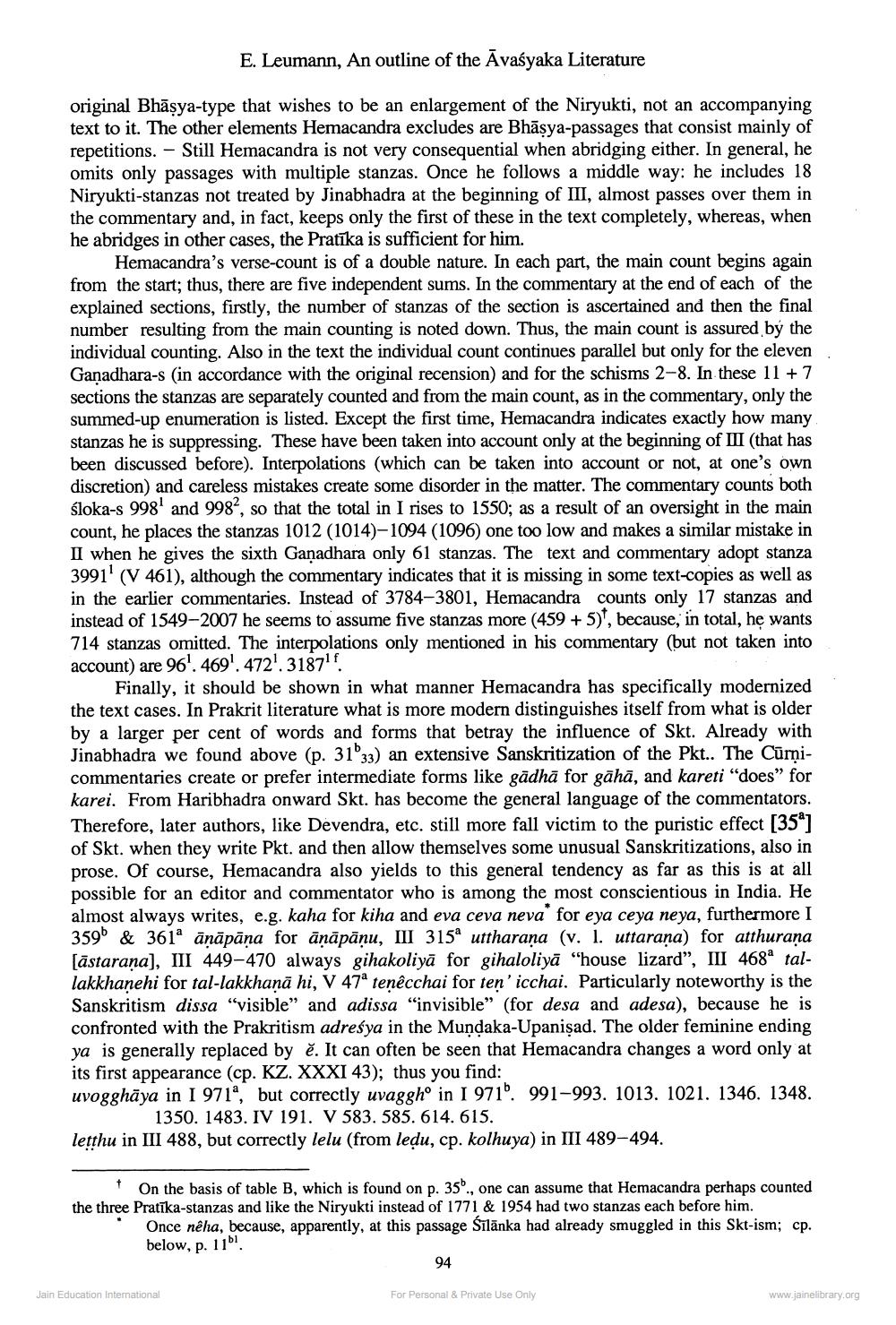________________
E. Leumann, An outline of the Āvaśyaka Literature
original Bhāsya-type that wishes to be an enlargement of the Niryukti, not an accompanying text to it. The other elements Hemacandra excludes are Bhāsya-passages that consist mainly of repetitions. - Still Hemacandra is not very consequential when abridging either. In general, he omits only passages with multiple stanzas. Once he follows a middle way: he includes 18 Niryukti-stanzas not treated by Jinabhadra at the beginning of III, almost passes over them in the commentary and, in fact, keeps only the first of these in the text completely, whereas, when he abridges in other cases, the Pratīka is sufficient for him.
Hemacandra's verse-count is of a double nature. In each part, the main count begins again from the start; thus, there are five independent sums. In the commentary at the end of each of the explained sections, firstly, the number of stanzas of the section is ascertained and then the final number resulting from the main counting is noted down. Thus, the main count is assured by the individual counting. Also in the text the individual count continues parallel but only for the eleven Ganadhara-s (in accordance with the original recension) and for the schisms 2-8. In these 11 + 7 sections the stanzas are separately counted and from the main count, as in the commentary, only the summed-up enumeration is listed. Except the first time, Hemacandra indicates exactly how many stanzas he is suppressing. These have been taken into account only at the beginning of III (that has been discussed before). Interpolations (which can be taken into account or not, at one's own discretion) and careless mistakes create some disorder in the matter. The commentary counts both śloka-s 998' and 998”, so that the total in I rises to 1550; as a result of an oversight in the main count, he places the stanzas 1012 (1014)-1094 (1096) one too low and makes a similar mistake in II when he gives the sixth Gañadhara only 61 stanzas. The text and commentary adopt stanza 3991' (V 461), although the commentary indicates that it is missing in some text-copies as well as in the earlier commentaries. Instead of 3784-3801, Hemacandra counts only 17 stanzas and instead of 1549-2007 he seems to assume five stanzas more (459 + 5), because, in total, he wants 714 stanzas omitted. The interpolations only mentioned in his commentary (but not taken into account) are 96!. 469'. 472. 31871f.
Finally, it should be shown in what manner Hemacandra has specifically modernized the text cases. In Prakrit literature what is more modern distinguishes itself from what is older by a larger per cent of words and forms that betray the influence of Skt. Already with Jinabhadra we found above (p. 31'33) an extensive Sanskritization of the Pkt.. The Cūrņicommentaries create or prefer intermediate forms like gādhā for gāhā, and kareti "does" for karei. From Haribhadra onward Skt. has become the general language of the commentators. Therefore, later authors, like Devendra, etc. still more fall victim to the puristic effect [35] of Skt. when they write Pkt. and then allow themselves some unusual Sanskritizations, also in prose. Of course, Hemacandra also yields to this general tendency as far as this is at all possible for an editor and commentator who is among the most conscientious in India. He almost always writes, e.g. kaha for kiha and eva ceva neva for eya ceya neya, furthermore I 3590 & 361" āņāpāņa for āņāpāņu, III 315o uttharana (v. 1. uttarana) for atthurana [ästarana), III 449-470 always gihakoliyā for gihaloliyā "house lizard”, III 468a tallakkhanehi for tal-lakkhaņā hi, V 479 tenêcchai for ten' icchai. Particularly noteworthy is the Sanskritism dissa "visible" and adissa “invisible" (for desa and adesa), because he is confronted with the Prakritism adresya in the Mundaka-Upanişad. The older feminine ending ya is generally replaced by ě. It can often be seen that Hemacandra changes a word only at its first appearance (cp. KZ. XXXI 43); thus you find: uvogghāya in I 971", but correctly uvaggho in I 971'. 991-993. 1013. 1021. 1346. 1348.
1350. 1483. IV 191. V 583.585. 614.615. letthu in III 488, but correctly lelu (from ledu, cp. kolhuya) in III 489–494.
* On the basis of table B, which is found on p. 356., one can assume that Hemacandra perhaps counted the three Pratīka-stanzas and like the Niryukti instead of 1771 & 1954 had two stanzas each before him.
Once nêha, because, apparently, at this passage Sīlānka had already smuggled in this Skt-ism; cp. below, p. 115.
94
Jain Education International
For Personal & Private Use Only
www.jainelibrary.org




